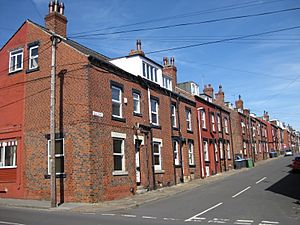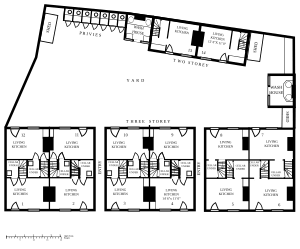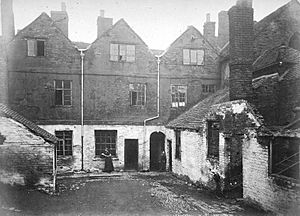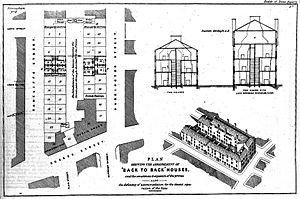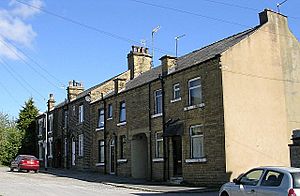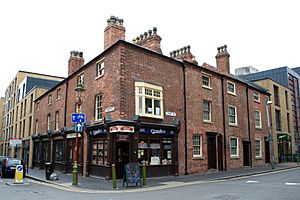Back-to-back house facts for kids
Back-to-backs are a special type of terraced house. They were built mostly between the late 1700s and early 1900s. Thousands of these homes were made during the Industrial Revolution. This was when many people moved to cities for factory jobs. Back-to-backs share walls on two or three sides. Their only door and windows are at the front.
These houses were built as cheaply as possible for working-class families. Because of this, they were often not very well made. Their design meant they didn't get enough fresh air or good plumbing. Toilets and water taps were often shared by many families in a small courtyard. Back-to-backs became known for poor health and hygiene.
By the mid-1800s, people realised these houses were unhealthy. A law called the Public Health Act 1875 allowed cities to stop new back-to-backs from being built. Newer homes, called byelaw terraced houses, then became common. However, Leeds City Council chose not to stop building them. So, back-to-back houses kept being built in Leeds until the 1930s.
Most back-to-backs were later torn down to improve living conditions. But many still stand in Leeds and Bradford today. Cities like Birmingham and Liverpool, which once had many, kept just one example. These are now museums for visitors. The Birmingham Back to Backs are run by the National Trust. Other museum examples are at the Museum of Liverpool and Bradford Industrial Museum.
Contents
What are Back-to-Back Houses?
These houses were built very close together for working people. Builders didn't think much about space, comfort, or quality of life. Most back-to-backs were small. The earliest ones had just one room on each floor. Later ones were "two-up two-down," meaning two rooms upstairs and two downstairs. Each house shared a back wall with another house or a factory.
Since they shared three of their four walls, back-to-back houses were often dark and had poor air circulation. At first, hygiene was not a concern. Some houses were even built over open drains, covered only by wooden boards.
It's important not to confuse "back-to-back" houses with "through" terraced houses. Through-houses have backs that face each other across an alley. They are not directly joined like true back-to-backs. Sometimes, back-to-backs were called "blind-backs," especially if they were built against factory walls.
History of Back-to-Backs
Early Homes and Growth
By 1800, Leeds had about 30,000 people. This number quickly grew, leading to a housing shortage. The first back-to-back houses appeared around 1790 in Briggate, Leeds. Builders found them cheap to construct. They didn't need roads or drainage at the back. This allowed up to 300 people to live on just one acre of land.
There was no standard way to build these houses. The worst and earliest ones had only one room per floor. They also had no protection against dampness. Toilets were often shared outdoor "earth toilets" in any available space. Water came from shared public taps that didn't always work. At first, houses were built around shared courtyards. Later, they were built directly onto streets.
These houses became common in inner city areas of Victorian England. Many were found in Birmingham, Bradford, Leeds, Liverpool, Manchester, Salford, and Nottingham. In Nottingham, about 68% of all houses were back-to-backs. City officials knew these homes were not ideal but struggled to stop their construction.
Mill and mine owners built many back-to-backs in the 18th and 19th centuries. They wanted to house as many workers as possible in a small area. This kept costs low. Some people argued they were easier to keep warm because they had only one outside wall. However, having no backyards meant no space for private outdoor toilets. Shared toilets quickly spread diseases. In older parts of Birmingham, back-to-backs were linked to dirt, bad air, and stagnant water.
Changes in the 1800s
Fast city growth meant fields and gardens disappeared. They were replaced by cheaply built houses, packed tightly together. Houses were built on weak foundations with poor materials to save money. Each house was separated by a single brick wall. Ground-floor rooms served many purposes, while upstairs rooms were bedrooms. By the 1830s, back-to-backs were known across the country for spreading disease. Major cities like Manchester and Liverpool banned their construction by the mid-1800s.
The Leeds Improvement Act of 1866 brought new rules for houses. These included gated yards, wider streets, and better indoor designs. Around 1880, the city's chief health officer tried to stop back-to-back building, but failed. By then, about 200 people lived in 50–60 houses per acre.
In the late 1800s, the byelaw terraced house was introduced. These homes followed the Public Health Act 1875 and had better designs. By 1890, more improvements came. These included a basement or ground-floor kitchen, a small garden, and a private toilet for each home. These changes were required by new housing laws.
However, Leeds was different. In 1899, 72% of all new houses built in Leeds were still back-to-backs. This number didn't drop until 1914. Small families in Leeds often had no choice but to live in them because they were cheaper. Even though new rules were supposed to stop back-to-backs, Leeds Council didn't enforce them at first. This meant builders put their profits ahead of quality. As a result, houses in Leeds were often more crowded and of lower quality than in other towns. For example, a new house in Sunderland would have its own toilet, but a new one in Leeds might share one until 1912.
The 1900s and Demolition
Before the First World War
By the early 1900s, back-to-back houses were disliked by both residents and the government. They wanted to ban new ones and tear down old ones due to health worries. People living in back-to-backs had worse health. They had higher death rates, more infectious diseases, and more diarrhoea. In Manchester, a doctor found that people in back-to-backs had a 40% higher death rate than those in through-houses. In 1909, a new law officially banned building this style of house.
Between the World Wars
After the First World War, council housing began. Councils started tearing down slums as part of rebuilding plans. This picked up speed in the 1920s. Many back-to-back houses were demolished, and new "homes fit for heroes" were built.
In Leeds, the council spent about £1 million (a lot of money back then!) buying old back-to-backs to tear them down. Yet, they kept building improved ones of a similar style until 1937, even though they were outlawed in 1909. By 1926, Leeds had 72,000 back-to-backs. About 32,000 of these were called "abominations" and had been unfit for years. Only 12,000 (less than 17%) were considered moderately healthy. Other cities had fewer, like Bradford (33,000) and Nottingham (5,000). In 1930, a Member of Parliament described Leeds as having "an unenviable notoriety for its back-to-back houses." He even suggested allowing new ones to be built in blocks of four. He thought this would be cheaper and solve the ventilation problems.
After the Second World War
After the Second World War and the bombing of cities, Britain was ready for another wave of slum clearance. For example, Birmingham had about 40,000 back-to-backs in 1931, but only about 29,000 by 1946.
Around 1953, Leeds had 30,000 people waiting for council homes. About 16,000 of these people lived in back-to-backs built before 1844, which were set to be cleared. These older houses were in bad shape and often overcrowded. By 1959, Leeds and Birmingham each still had about 60,000 back-to-back houses. MPs called for them to be torn down faster. One MP, William Wheeldon, sadly noted that little had changed for generations:
Its main problem, besides being small, damp, and falling apart, is that it's not self-contained. There's no water inside the house, no proper way to get rid of dirty water, and the only toilet is often far from the house and shared by two or more families. This toilet is often in a disgusting state because it's shared. Many houses have no bath or way to take a bath. The view from these houses is ruined by soot in a smoky atmosphere.
Many of these houses, I'm sad to say, are in my area. Men went from these houses over forty years ago to fight in the 1914–1918 war. They were told they would have homes for heroes. Yet the sons of those men went from the same houses in 1939 to fight for their country, and many of those houses are still standing today.
Demolition continued across the country through the 1960s and 1970s. By the late 1970s, Leeds was the second largest city outside London that still had about 30,000 back-to-back houses. By the 1980s, most towns had few or no back-to-backs left.
Back-to-Backs Today
Leeds and its nearby areas are the only places where many back-to-back houses still exist. They have been updated with "mod cons" like indoor bathrooms and central heating. These modernised back-to-backs are popular because they are easier to look after than typical houses. They have also been popular with people who buy houses to rent them out.
Even though new back-to-backs are banned by current building rules, some architects want the rules to be relaxed. They argue that many of the old health problems, like open sewers and shared toilets, are no longer an issue.
A study in 2008 asked people living in these homes what they thought. This was to help ensure the houses could continue to be used. 75% of those asked felt the history of the houses was important to Leeds' identity. Overall, 51% had positive feelings, and 45% felt negatively about them. Residents strongly valued their history, but their opinions weren't always as valued as those of non-residents or experts.
Back-to-Back Museums
The Birmingham Back to Backs is a historic house museum. It shows the last remaining back-to-back houses in the city. The homes are decorated to look like they did in the 1800s. They are now protected as Grade II listed buildings. According to the BBC, this is the last example of such houses grouped around a courtyard.
In Liverpool, back-to-back court housing once housed over 40% of its people. They were torn down in the 1960s and 1970s as part of slum clearance. However, a set of nine pairs of these houses survived. They were restored as a museum attraction. A plan to save and restore the city's last surviving block of court housing was made in 2016. Work was done to make the building safe and add a new roof. This project adds to the existing court homes at the Museum of Liverpool. This museum opened in 2011 and shows a recreated street from 1870.
The Bradford Industrial Museum has a block of back-to-backs. They are decorated to show what homes looked like in 1875, during the Second World War, and in the 1970s.
See also
- Nagaya (architecture), a Japanese version


